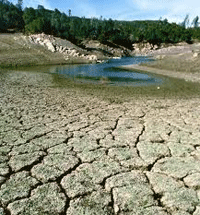WARMING of the oceans is a natural process. However, to heat an ocean is not as simple as heating a glass of water. Due to its large size, depth and distribution, it is impossible for oceans to be heated equally in all places. Hence, the oceans collect more heat in some places than in others.
 The oceans receive heat from two sources: sunlight and infrared radiation re-emitted from the greenhouse gases in the lower atmosphere.
The oceans receive heat from two sources: sunlight and infrared radiation re-emitted from the greenhouse gases in the lower atmosphere.
• Sunlight penetrates the water readily, thus directly heating the ocean to a considerable depth. About 3% of the energy from sunlight entering the ocean reaches a depth of about 100 metres, therefore the entire top 100 metres of the ocean is heated easily by sunlight. However, below 100 metres, very little sunlight is able to penetrate, therefore, the deeper the ocean gets it becomes darker and colder.
• The second source of heat for the ocean is infrared radiation, which is re-emitted from the greenhouse gases in the lower atmosphere. However, this barely affects the temperature of the water, usually heating only the top few millimetres of the ocean.
Since sunlight and infrared radiation readily heat the surface of the water but are unable to penetrate deep down into the ocean, we find that the equatorial oceans are typically warm, usually having a temperature of 27 – 28 °C. The deeper parts of the ocean, whether in the tropics or near the poles, remain very cold, at a constant temperature of around 1 – 2 °C.
The heat that the lower ocean receives is usually through natural mixing which is a result of wave action caused by friction with the atmosphere.
Global Warming
Due to an increase in greenhouse gases such as carbon dioxide, methane, water vapour and nitrous oxide in the atmosphere, there has been an increase in global temperature by about 1°F (0.6°C) over the past century. This increase in greenhouse gases has been attributed to human activities such as deforestation and use of fossil fuels. These gases absorb heat energy in the form of infrared radiation emitted from the Earth’s surface, regulating the temperature of the earth.
Even the temperature of the oceans is raised through this effect, increasing by about 0.03 °C. This warming has occurred from the surface to a depth of about 2,300 feet (700 metres), where most marine life thrives.
Scientists have declared that if this deep ocean heating were going into the atmosphere instead it would be warming at a rate of about 3 °C (over 5 °F) per decade.
Effects
This increase in the ocean’s temperature has had a number of effects. • Higher Sea Levels
• Higher Sea Levels
When water heats up, it expands. Therefore, one of the biggest consequences of higher sea temperatures is a rapid rise in sea level. Sea level rise would affect coastal areas greatly, resulting in floods, shoreline erosion, and more powerful storm surges that can devastate low-lying areas.
• Stronger Storms
Many weather experts say we are already seeing the effects of higher ocean temperatures in the form of stronger and more frequent tropical storms and hurricanes/cyclones. Warmer surface water diffuses more readily into vapour, making it easier for small ocean storms to develop into larger, more powerful systems. These stronger storms can increase damage to the built environment when they get to land. They can also harm marine ecosystems such as coral reefs and kelp forests. In addition, an increase in storm frequency means less time for these sensitive habitats to recover.
These stronger storms can increase damage to the built environment when they get to land. They can also harm marine ecosystems such as coral reefs and kelp forests. In addition, an increase in storm frequency means less time for these sensitive habitats to recover.
• Other Consequences
Warmer sea temperatures are also associated with the spread of invasive species and marine diseases. One of the factors for a stable marine environment is water temperature. As this temperature increases and the ecosystems become warmer, outside species are able to thrive in areas where they were not previously comfortable. This also makes the habitat unsuitable for native species, causing forced migrations and species extinction.
Warmer seas also lead to melting from below of polar ice shelves, weakening their structure and leading to spectacular shelf collapses. Scientists also worry that warmer water could interrupt the ‘thermohaline currents’ that is largely responsible for regulating the Earth’s temperature. Hence, affecting this current could contribute to further rapid climate changes.
Source: http:john-daly.com/deepsea
http:ocean.nationalgeographic.com
You can share your ideas and questions by sending letters to: “Our Earth, Our Environment”, C/O EIT Division, Environmental Protection Agency, Ganges Street, Sophia, GEORGETOWN or email us at eit.epaguyana@gmail.com




.jpg)










